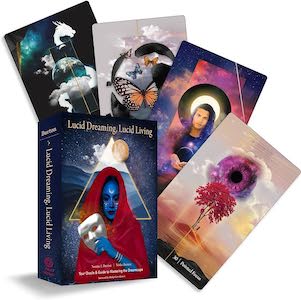
Lucid Dreaming, Lucid Living: Your Oracle & Guide to Mastering the Dreamscape, by Norma J. Burton & Nisha Burton
Red Wheel, 1590035380, 200 pages, 44 cards, September 2023
If you have ever had the wild experience of knowing you were dreaming within a dream, and then discovered that you had the ability to manipulate the dream world with your thoughts, then you have tapped into the latent power of lucid dreaming. Lucid dreaming is a potent therapeutic practice that can reduce stress, improve memory, and assist in shadow integration, healing trauma, and overcoming addiction. Lucidity also enhances personal empowerment by bringing mindfulness and a greater sense of agency to both dreams and waking reality. The average person has three to seven oneiric visions a night, but 95 percent of these experiences are forgotten upon waking.1 Fortunately, dream recall is a skill that can be strengthened with practice, and the Lucid Dreaming, Lucid Living oracle teaches dreamers how to achieve conscious awareness and navigate their dreamscapes with intention.
Lucid Dreaming, Lucid Living: Your Oracle & Guide to Mastering the Dreamscape is a collaborative project created by Norma and Nisha Burton, a mother and daughter dream team.2 Transpersonal psychologist Norma Burton has over thirty years of experience in her personal practice, and her work is informed by Jungian analysis, applied neuroscience, and comparative world religions, with an emphasis on Buddhism. Norma also apprenticed with Mexican Huichol shamans for twenty years, who gave her permission to incorporate their shadow healing tradition into her practice, and she is well versed in the shamanic traditions of other cultures, such as the Japanese Shugendo mountain shamans, the Brazilian Condoble-Espiritu healers, and the North American Cherokee, Hopi, Iroquois, and Navajo healers. Norma’s daughter, Nisha Burton, is a visual artist, graphic designer, and filmmaker, whose unique artistic vision enlivens the surreal dreamscapes pictured on the cards.3
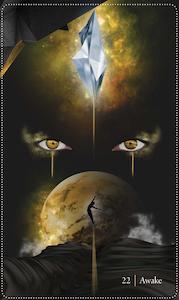
This beautiful oracle consists of 44 gilded cards and a glossy full-color 200 page companion guidebook. In the guidebook, each card has a “Lucid Dreaming Teaching” and a “Lucid Living Message,” which advises the dreamer on how to integrate the lesson in both dreaming and waking life.
The cards are divided into three categories, recognizable by their black, white, and starry night sky backgrounds. The black cards, numbered 1 through 22, are for “Lucid Dream Journeys”; the white cards, numbered 23 through 33, are for “State Checks, Stabilizing, and Reality-Shifting”; and the starry night cards, numbered 34-44, represent “Guides and Guardians.” [14-15]
The black cards give guidance for navigating various types of dreamscapes. Three of these cards (Card 6, “Nightmare Rewrite,” Card 12, “False Awakening,” and Card 13, “Sleep Paralysis”) advise on how to overcome frightening dream experiences by using your personal power to flip the script of the dream or transform these scenarios into opportunities for greater lucidity and mobility through out-of-body experiences.
One of my favorite cards is number 7, titled “Portals,” which teaches that “in lucid dreams, mirrors are entryways into other realities.”4 The Lucid Living message says, “Use them in waking reality to focus on what you like about yourself rather than your perceived flaws.”5 This card delighted me because I use black mirror scrying in my shadow work, and after reading about this card in the guidebook, I had a vivid dream in which I continued this practice in my sleep.
The white cards teach various practices, called “state checks,” which can help one become lucid while dreaming. The guidebook defines a state check as “an action you conduct during the day to ‘check’ what ‘state’ or reality you are in—dreaming, awake, or out-of-body.”6 State checks performed in the dream realm can trigger lucidity. For example, card 27, titled “Solid Structures,” advises you to touch objects that should be solid to see if your hand will pass through them.7 Performing this state check throughout the day can help program your mind to do the same while dreaming, and will also heighten your critical thinking skills in waking reality.
The starry night cards depict archetypal guardians and guides that you may encounter in the dream realms. They often represent subconscious aspects of yourself seeking integration, such as your “Cosmic Self and Inner Child,” and “Animal Guides” whose spiritual powers may benefit you at this time.
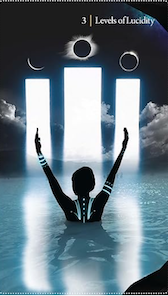
I was eager to dive headfirst into this deck. For my first reading, I drew Card 16, “The Three Worlds” and Card 9, “The Dream World Home Base.” Both of these cards are black cards for lucid dream journeys, and feature locations in the Dreamtime, reminding me of a star map.
“The Three Worlds” card depicts the three shamanic realms that dreamers can access. In “The Three Worlds” card:
“The dreamer navigates upward through the three worlds—the Underworld, the Middle World, and the Upper World. She has learned how to differentiate and distinguish between these dimensions and has integrated the powerful lessons held in each one.”8
The keywords associated with this card are: “Moving, State of flux, Re-surfacing of old wounds, Power struggles, Survival needs, Internal metamorphoses.”9
Working with “The Three Worlds” card entails me categorizing my dreams according to which shamanic realm they take place in. For example, I’ve noticed that all of my Underworld dreams take place underground, in some sort of catacomb, tomb, cave, or the basement of a large haunted house. According to the “Lucid Living Message” in the guidebook, Underworld dreams “include the resurfacing of psychological wounds that occurred in your childhood. It may be related to ancestral baggage and the need to heal patterns from your lineage.”10
The night before I drew this card I had a vivid Underworld dream. I dreamed I was speaking with my deceased father in a room with earthen walls, which I realized was his grave when I woke up. We were both crying in the dream, and it felt like we were resolving unfinished business between us.
Middle World dreams are out-of-body experiences and mirror the earth plane. I began experimenting with astral projection when I was around 12 years old. Even though I had lucidity during these experiences, I had difficulty directing where I went and often lost consciousness and fell deeper into sleep.
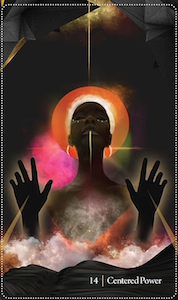
My Upper World dreams often involve spirit flights through space. In these vivid dreams, my astral body rockets through the earth’s atmosphere at the speed of thought, visiting the moon and planets both in this solar system and beyond. The most vivid one involved me floating near the rings of Saturn. I had a frightening sense of weightlessness and being suspended in the black void of space without any kind of tether to ground me and guide me back to earth. After reading the guidebook cover to cover, I was amazed to find a card titled “The Void” that describes this experience. I thought it was unique to me but apparently it is common among dreamers to encounter “The Void.”
Sometimes these Upper World dreams involve me being on earth, but looking up at the sky to see the planets looming larger than life overhead and being drawn down towards me. I have also seen UFOs phasing in and out of the earth plane, revealing themselves to me by flickering like blue holograms. These dreams are frightening, because the veil thins and I become aware that there are alien forces all around us, cloaked so that most people can’t see them. I get the sense that these mysterious vessels are influencing our reality but I can’t discern how or what their intentions are.
The second card I drew was “Dream World Home Base.” This card advises me to establish a safe and secure home base to ground myself in the ever-shifting dream realms. The guidebook suggests creating a home base through visualization, and locking the entrance so it is only accessible to me.
This card reminded me of the astral castle I created in my late teens, and still visit on occasion. My favorite space is a reading room in a huge private library, with multiple floors of oak bookshelves and warm sunlight streaming through stained glass windows. There is a cloistered garden outside with a beautiful snow-white peacock that eats out of my hand. I haven’t visited in a while so I’m going to make some improvements and peruse the shelves.
“If your home base is on another planet,” the guidebook says, “try putting a fingerprint or eye-scanning device on the portal to secure it.”11
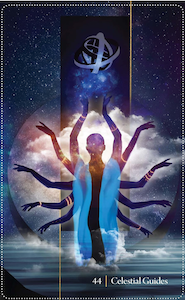
The thought had never occurred to me to create my own dream planet as a home base, and I love the idea. Perhaps these cards are telling me that I already have a home base on another world that I may soon discover in my dreams.
I learned so much about dreaming from this comprehensive guidebook. It turns out that many experiences I thought were strange or unique to me are actually common dream experiences that are explored in one of the cards. While I haven’t had a fully lucid dream recently, using this deck has improved my dream recall and motivated me to be more consistent in journaling about my dreams.
I have noticed that I often achieve a certain degree of lucidity in dreams, even if only for a brief moment of awareness that I am dreaming. For example, if my conscious mind is resistant to what is happening in the dream, I will remind myself to allow the dream’s narrative to unfold organically and witness it, so I can see what message it has for me. I have found that trying too hard to control and shape the dream takes too much psychic energy and exhausts me out of lucidity. I also like the surprises that come through the natural progression of dream sequences. For me, the most important benefit of lucidity is dream recall. I would rather observe the dream with mindful awareness and wake up to write it down rather than try to exert control over what happens and risk losing lucidity.
The Lucid Dreaming, Lucid Living oracle is a phenomenal tool for mindful dreaming, astral projection, and deepening self-knowledge through shadow work. Both beginning and seasoned lucid dreamers will be inspired by this visually stunning deck and insightful guidebook, which teaches us the value of being present, as we lead double lives in our waking and dreaming realities.
Are you awake right now? Or are you dreaming?

Rachel Christina McConnell is a witch, tarot reader, intuitive astrologer, and writing spider. She holds an MFA in Fiction from Columbia University in the City of New York. Her short stories have appeared in Dark Moon Lilith Press and Minerva Rising Press’s The Keeping Room. Links to her publications are available here: https://rachelchristinamcconnell.wordpress.com



